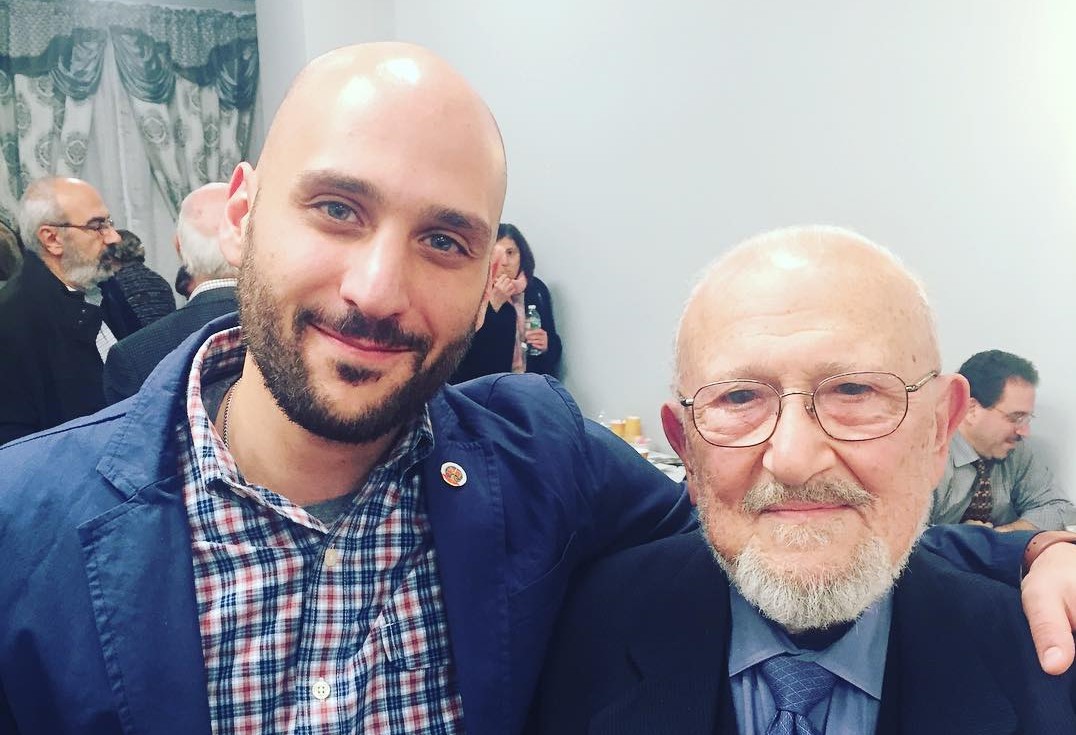Co-translators Rupen Janbazian and Tatul Sonentz-Papazian
Interview with Translator Rupen Janbazian
On January 11, The Hairenik Press published the first ever English translation of Andranik Tzarukian’s long-form poem Letter to Yerevan («Թուղթ առ Երեւան» “Tught ar Yerevan”).
The translation was a collaborative effort between the former director of the ARF and First Republic of Armenia Archives and former editor of the Armenian Review Tatul Sonentz-Papazian and former editor of the Armenian Weekly Rupen Janbazian.
Here’s TorontoHye’s interview with Janbazian regarding the significance of the poem and the collaborative work with Sonentz-Papazian.
TorontoHye: Why did you choose to translate this particular text?
RJ- I first read «Թուղթ առ Երեւան» (Letter to Yerevan) about 16 years ago—while still in high school. We had read a snippet of the poem while studying the life and works of Andranik Tzarukian in Armenian literature class at ARS Armenian School. I had previously read his orphanage memoir «Մանկութիւն չունեցող մարդիկ» (Those without a Childhood), which had quickly become one of my favourite pieces of Armenian literature. After reading that excerpt of «Թուղթ առ Երեւան», I was hungry for more, so our teacher Mr. Moushegh Karakashian lead me to our school library where there was a copy of the long-form poem.
It captivated me, even though I was not familiar with a lot of the rich vocabulary. I would pester Baron Moushegh every so often and ask what Tzarukian meant by this of that particular word or phrase. He did a spectacular job of patiently explaining unfamiliar words and giving me a better understanding of the historical context of the poem.
One thing that struck me was the impact the poem on Baron Moushegh’s generation. He told me that he and his friends had memorized the 60-or-so page poem by heart and it boggled my mind at the time—I couldn’t fathom having to learn anything so long by heart. I knew then that it must have been good piece!
It was then that I decided that the work should be translated into English, so that my generation, which is more comfortable reading English, could appreciate it as much as generations that came before ours.
About 14 years after first reading the poem and thinking about translating it, I brought up the idea to one of my mentors and good friends Tatul Sonentz-Papazian, who was ready to collaborate on the project. I was ecstatic, to say the least.
We announced the translation on May 28, 2017—the 99th anniversary of the First Republic of Armenia—and decided to publish the poem periodically in the Armenian Weekly, with the intention of finishing off the translation on the centennial anniversary of the establishment of the Republic. After the publication of about eight small sections in print and online, the Hairenik Press expressed interest to publish it in book-form as a part of the Hairenik Association’s 120th anniversary celebrations. And the rest is history!
TorontoHye: Tell us about working with Sonentz-Papazian.
RJ- Working with Tatul can only be described as a dream come true. I remember reading his translations of [Hakob] Karapents’ Return & Tiger and of countless poems by [Daniel] Varuzhan, [Yeghishe] Charents, and so forth, and thinking, “how cool would it be to get to know this man?” Life has a funny way of working out and I ended up working in the same building as Tatul in Watertown, Mass. for more than three years. Despite being two generations apart, we quickly became great friends and would spend countless hours together discussing politics, literature, and life.
During one of our conversations in the basement of the Hairenik building in Watertown, Mass., the two of us asked ourselves: If Tzarukian’s masterpiece had been so cherished for decades, why does it appear to have become so irrelevant today? This really kick-started the translation process. I consider myself lucky to have a friend like Tatul—and even luckier to have had the chance to work with him one-on-one. I learned a lot about translating from him.
TorontoHye: When first released nearly 75 years ago, Tzarukian’s poem flew off the shelves. Tell us more about the poem. What made it so important when it was first released?
RJ- In 1944, Soviet Armenian writer Gevorg Abov wrote a poem entitled, «Մենք չենք մոռացել» (“We Have Not Forgotten”). In his poem, he criticized the Armenian Revolutionary Federation (ARF) and its entire membership for being traitors of the Armenian nation and its people. In his various writings and public speeches, Abov was particularly critical of the First Republic of Armenia (1918-1920) and its leadership.
Abov’s poem touched a nerve with Tzarukian. Although Abov had addressed his poem to the entire ARF, Tzarukian felt it was his responsibility to respond and to disclaim «Մենք չենք մոռացել». Written in Aleppo in 1944 and first published in 1945 «Թուղթ առ Երեւան» examines the history of the ARF and aims to dismiss Abov’s claims that the organization harmed the interests of the Armenian people. Almost overnight, Tzarukian became a dominant voice in Armenian life, and his poem quickly spread through the Armenian Diaspora, from the Middle East to Europe and the Americas.
The poem was republished several times over in various Armenian communities—including in Syria, the United States, Lebanon, and Cyprus—up until the early 1990s, and as a result became a source of inspiration for tens of thousands.
Like you mentioned in your question, when first released, copies of «Թուղթ առ Երեւան» literally sold like hotcakes, leading to almost a dozen reprinted editions in the first decade alone. Funny enough, about a month after our translation was released, I realized that the book had a small “Bestseller” tag on Amazon. Sure, it might have only been a bestseller in Amazon’s Russian and Former Soviet Union Poetry section—which really isn’t a big deal—but almost three-quarters of a century after it was released, Թուղթ is technically a bestseller once again, which made me smile. Knowing that Tzarukian is technically as bestseller once again made my smile…
Tzarukian’s language in the poem is flowery and beautiful. Perhaps more importantly though, it is jam-packed with information—it’s really an Armenian History lesson told in verse.
TorontoHye: Titles say a lot; a reader is either drawn to it or remains indifferent. Letter to Yerevan, has that quality of drawing the reader to open the book. What can you say about the title of the poem?
RJ- Tzarukian’s title «Թուղթ առ Երեւան» is pretty damn powerful. Although it is often described as a response to a single poem, Tzarukian’s work is—in reality—a response of the Soviet intelligentsia of the time, which was continuously bombarding the ARF and its leadership with attacks of every kind. Of course, most of the time, the attacks were ordered by the powers that be in Soviet Armenia, which is why Tzarukian’s title is directed at all of [Soviet] Yerevan and not just Abov—«Թուղթ առ Աբով» would have made quite a weak title!
As a Western Armenian author, Tzarukian even wrote the whole thing in Eastern Armenian—quite beautifully, too—so that everyone reading it in Armenia would understand every single word. Reading the poem, it is difficult to imagine that Tzarukian wasn’t an Eastern Armenian writer.
When translating the title, we came across a few different iterations used in English-language books and textbooks on Armenian literature. One translation of «Թուղթ առ Երեւան» we much liked was “Message to Yerevan,” however, we felt as though it was not powerful enough and did not convey the right emotion.
At one point, early on in Tzarukian’s work, he writes:
You have evoked me from the Homeland
And written a letter with cutting words,
And laced the words with fire
And the fire with poison and hemlock
And you say to me,
“I have not forgotten you.”
We figured since Tzarukian considered Abov’s poem to be a letter, then «Թուղթ առ Երեւան» could be considered a response letter—that’s how we came up with Letter to Yerevan!
TorontoHye: What is the importance of translating poems like Tzarukian’s masterpiece?
RJ- If there is one reality that Armenians in the Diaspora must accept today, it is that based strictly on population figures we are but a drop in an ocean. Armenians rarely constitute even half a percent of a city’s or country’s population. How, then, can we expect the new generations of Armenians in North America to maintain the mother tongue in an environment dominated by another language—in the case of North America, English?
Making foundational texts like «Թուղթ առ Երեւան» available in English can only create opportunities for such text to be read not only by Armenians but also by others. In translation, those texts can again inspire, becoming for English-speaking readers what they were for previous generations of Armenians. We also hope that our humble attempt might prompt Armenian youth to engage with and learn Armenian, the language of the original text. That is why we found it integral to include the original Armenian—which has not been republished in decades—along with the translation.
The Armenian language is central to our cultural identity, of course; but what is also vital is that texts embodying the many facets of the Armenian experience be read—whether in Armenian or English, or any other language, for that matter. Even if only so that new generations may feel some small part of the revolutionary spirit that has inspired so many of our greatest modern writers and artists.
TorontoHye-What’s the significance of the book at this juncture of our national discourse (ազգային կեանք)?
RJ- I think that it is very important to understand the historical context before diving into Letter to Yerevan, which is we are lucky to have had such a powerful and carefully-crafted introduction written by another former Armenian Weekly editor, Vahe Habeshian.
In his preface, he writes that Հակադաշնակցականութիւն— or “anti-ARFism”—has existed and continues to exist because the ARF existed and exists as a significant enough threat “to warrant consideration or reaction.” And as such, Habeshian argues that it is appropriate for the ARF today to keep events in our national discourse—especially sentiments in Armenia, including the recent Velvet Revolution and its wake—in historical perspective and not to use anti-ARF sentiment as opportunities to blame others when or to justify its own mistakes or unpopular decisions.
Letter to Yerevan is very much a “Cold-War story,” but it is also a body of work that goes beyond just the East vs. West context and gives an unadulterated history of the Armenian people that would have been largely ignored—even forbidden from coming to light—in Soviet Armenia.
There are many lessons for us today in Letter to Yerevan, even though it is now a nearly a 75-year-old poem. The beauty of poetry is that each reader will interpret the content and language in his or her own way.
TorontoHye- When the translation was published, it was announced that all of the proceeds from the sales of the book will go directly to the Hairenik Newspaper Digitization Project. Tell us a little more about that.
RJ- Tatul and I, along with English and Armenian editors Vahe Habeshian and Yeprem Tokjian; illustrator Meruzhan Khachatryan; as well as designers Hovig Afarian and Varak Karakashian, decided to donate our time and efforts to making the publication of this book a reality. We wanted the money to go to a worthwhile cause, so we decided to allocate the funds to something we believe can help inspire and educate generations.
The Hairenik Association was established in 1899 and is celebrating its 120th anniversary this year. As part of this celebration, the association announced that it has been digitizing its entire newspaper archive, which will soon be made available to the public. Of course, the digitization of printed materials that date back to 1899 requires meticulous professional expertise—which doesn’t come cheap—so we decided to help the ongoing fundraising efforts to make the project a reality.
One hundred percent of book sale proceeds will be donated to the Hairenik Association’s Newspaper Digitization Project, through which, the archives of the Hairenik Daily (Armenian), Hairenik Weekly (English), the Armenian Weekly (English), and the Hairenik Weekly (Armenian) will be digitized, completely searchable (optical character recognition) in both languages, and made available to students, researchers, and the general public. The newspapers are a treasure cove of information, history, and knowledge, and they have largely remained untapped due to their fragility and inaccessibility. Through the digitization project, we can change that.
TorontoHye- The book will be presented in Toronto on March 15th, correct?
RJ- Yes! The event will be taking place at the Armenian Community Centre of Toronto (Main Hall) and will be presented by one of my childhood friends Varak Babian, and Mr. Moushegh Karakashian, who introduced me to the text 16 years ago! There will also be readings in both Armenian and English and a book signing will follow the event.
A number of organizations—the Hamazkayin Armenian Cultural and Educational Society Toronto Klatsor chapter, the Hairenik Press, the Armenian Revolutionary Federation S. Tehlriian committee of Toronto, as well as the Armenian Youth Federation Toronto S. Zavarian chapter—have been gracious enough to co-sponsor this event. Admission is free and everyone is invited!
TorontoHye- Where is the book available for purchase?
RJ- The book is available in paperback and digital format on Amazon (U.S., Canada, and around the world). Paperback copies can also be purchased in many Armenian and non-Armenian bookstores in North America, including the Hamazkayin bookstores of Toronto and Montreal, Hairenik bookstore in Watertown, Mass., as well as Sardarabad and Abril bookstores in Glendale, Calif. Books will also be sold at all book events scheduled to take place.





